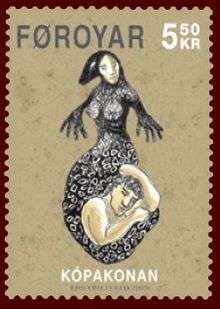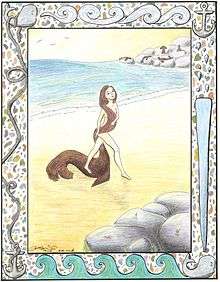Selkie
 A Faroese stamp | |
| Grouping | Mythological |
|---|---|
| Similar creatures | |
| Habitat | Water |
Selkies (also spelled silkies, sylkies, selchies; Irish: chéile séala, Scots: selkie fowk) are mythological creatures found in Irish, Scottish and Faroese folklore.[1] Similar creatures are described in the Icelandic traditions.[2] Selkies are said to live as seals in the sea but shed their skin to become human on land. The legend is apparently most common in Orkney and Shetland[3] and is very similar to those of swan maidens.[4]
Names and etymology
The word derives from earlier Scots selich, (from Old English seolh meaning "seal").[5] It occurs in various other spellings in Scots such as: selch(ie), sele, selch(e), selcht, se(a)lghe, selquh, saylche, sel(e)ich, selyh, selck, seall, seleché, seilché and selké.[6]
In Gaelic stories, there is no specific term for selkies as opposed to mermaids and they are invariably referred to as maighdeann mhara ("maiden of the sea" i.e. mermaids) but which clearly have the seal-like attributes of selkies.[7]
Legends
Male selkies are described as being very handsome in their human form, and having great seductive powers over human women. They typically seek those who are dissatisfied with their lives, such as married women waiting for their fishermen husbands. If a woman wishes to make contact with a selkie male, she must shed seven tears into the sea. If a man steals a female selkie's skin she is in his power and is forced to become his wife. Female selkies are said to make excellent wives, but because their true home is the sea, they will often be seen gazing longingly at the ocean. If she finds her skin she will immediately return to her true home, and sometimes to her selkie husband, in the sea. Sometimes, a selkie maiden is taken as a wife by a human man and she has several children by him. In these stories, it is one of her children who discovers her sealskin (often unwitting of its significance) and she soon returns to the sea. The selkie woman usually avoids seeing her human husband again but is sometimes shown visiting her children and playing with them in the waves.
Stories concerning selkies are generally romantic tragedies. Sometimes the human will not know that their lover is a selkie, and wakes to find them returned to their seal form. In other stories the human will hide the selkie's skin, thus preventing the selkie from returning to its seal form. A selkie can only make contact with one human for a short amount of time before the selkie must return to the sea. The selkie is unable to make contact with that human again for seven years, unless the human steals their selkie skin and hides it or burns it.[8]
In the Faroe Islands there are two versions of the story of the Selkie or Seal Wife. A young farmer from the town of Mikladalur on Kalsoy island goes to the beach to watch the selkies dance. He hides the skin of a beautiful selkie maid, so she cannot go back to sea, and forces her to marry him. He keeps her skin in a chest, and keeps the key with him both day and night. One day when out fishing, he discovers that he has forgotten to bring his key. When he returns home, the selkie wife has escaped back to sea, leaving their children behind. Later, when the farmer is out on a hunt, he kills both her selkie husband and two selkie sons, and she promises to take revenge upon the men of Mikladalur. Some shall be drowned, some shall fall from cliffs and slopes, and this shall continue, until so many men have been lost that they will be able to link arms around the whole island of Kalsoy, there are still occasional deaths occurring in this way on the island.

Peter Kagan and the Wind by Gordon Bok tells of the fisherman Kagan who married a seal-woman. Against his wife's wishes he set sail dangerously late in the year, and was trapped battling a terrible storm, unable to return home. His wife shifted to her seal form and saved him, even though this meant she could never return to her human body and hence her happy home.
Some stories from Shetland have selkies luring islanders into the sea at midsummer, the lovelorn humans never returning to dry land.[9]
A legend similar to that of the selkie is also told in Wales, but in a slightly different form. The selkies are humans who have returned to the sea. Dylan (Dylan ail Don) the firstborn of Arianrhod, was variously a merman or sea spirit, who in some versions of the story escapes to the sea immediately after birth.
Seal shapeshifters similar to the selkie exist in the folklore of many cultures. A corresponding creature existed in Swedish legend, and the Chinook people of North America have a similar tale of a boy who changes into a seal.
Theories of origins
Before the advent of modern medicine, many physiological conditions were untreatable. When children were born with abnormalities, it was common to blame the fairies.[10] The MacCodrum clan of the Outer Hebrides became known as the "MacCodrums of the seals" as they claimed to be descended from a union between a fisherman and a selkie. This was an explanation for the hereditary horny growth between their fingers that made their hands resemble flippers.[11]
Scottish folklorist and antiquarian, David MacRitchie believed that early settlers in Scotland probably encountered, and even married, Finnish and Sami women who were misidentified as selkies because of their sealskin kayaks and clothing.[11] Others have suggested that the traditions concerning the selkies may have been due to misinterpreted sightings of Finn-men (Inuit from the Davis Strait). The Inuit wore clothes and used kayaks that were both made of animal skins. Both the clothes and kayaks would lose buoyancy when saturated and would need to be dried out. It is thought that sightings of Inuit divesting themselves of their clothing or lying next to the skins on the rocks could have led to the belief in their ability to change from a seal to a man.[12]
Another belief is that shipwrecked Spaniards were washed ashore, and their jet black hair resembled seals.[13] As the anthropologist A. Asbjørn Jøn has recognised though, there is a strong body of lore that indicates that selkies "are said to be supernaturally formed from the souls of drowned people".[14]
Selkies in modern culture
Selkies — or references to them — have appeared in numerous novels, songs and films, though the extent to which these reflect traditional stories varies greatly. Works where Selkie lore forms the central theme include:
- The Secret of Roan Inish, a 1994 film about a young girl on the west coast of Ireland who discovers some of her ancestors and relatives are Selkies; when the Selkies take her little brother to live with them, she seeks to gain their favour and win him back.
- Song of the Sea, an Irish animated film about a young boy who must deal with the disappearance of his Selkie mother and his resentment of his sister, born when his mother disappeared.
See also
References
- ↑ Spence, Lewis (1948). The minor traditions of British mythology. Ayer Publishing. p. 55.
- ↑ "The Seal's Skin: Icelandic Folktale". The Viking Rune. Retrieved 12 May 2013.
- ↑ Westwood, Jennifer & Kingshill, Sophia (2011). The Lore of Scotland: A guide to Scottish legends. Arrow Books. pp. 404–405. ISBN 9780099547167.
- ↑ Monaghan, Patricia (2009). The Encyclopedia of Celtic Mythology and Folklore. Infobase Publishing. p. 411. ISBN 1438110375.
- ↑ "Selkie - Define Selkie at Dictionary.com". Dictionary.com. Retrieved 5 February 2016.
- ↑ "Selch". Dictionary of the Scots Language. Scottish Language Dictionaries Ltd. 2004. Retrieved 5 February 2016.
- ↑ MacIntyre, Michael (1972). "Maighdeann-mhara a' tionndadh na boireannach". School of Scottish Studies (in Scottish Gaelic). Tobar an Dualchais. Retrieved 5 February 2016.
- ↑ "Baily's Magazine of Sports & Pastimes". 42. July 1884: 355–356.
- ↑ Hardie, Alison (20 January 2007). "Dramatic decline in island common seal populations baffles experts". The Scotsman. Retrieved 17 September 2016.
- ↑ Eason, Cassandra. "Fabulous creatures, mythical monsters and animal power symbols". Fabulous creatures, mythical monsters, and animal power symbols: a handbook. pp. 147–48. Retrieved 11 May 2013.
- 1 2 Garry, Jane; El-Shamy, Hasan. "Animal brides and grooms". Archetypes and Motifs in Folklore and Literature. p. 97. Retrieved 11 May 2013.
- ↑ Towrie, Sigurd. "The Origin of the Selkie-folk: Documented Finmen sightings". Orkneyjar.com. Sigurd Towrie. Retrieved 30 November 2013.
- ↑ Silver, Carole B. Strange and Secret Peoples: Fairies and Victorian Consciousness. p. 47. ISBN 0-19-512199-6.
- ↑ Jøn, A. Asbjørn (1998). "Dugongs and Mermaids, Selkies and Seals". Australian Folklore. 13: 94–98. ISBN 1-86389-543-4.
Further reading
- Thomson, David. The People of the Sea: A Journey in Search of the Seal Legend.
- Briggs, Katharine. An Encyclopedia of Fairies, Hobgoblins, Brownies, Boogies, and Other Supernatural Creatures. ISBN 0-394-73467-X.
- Williamson, Duncan (1992). Tales of the seal people: Scottish folk tales. New York: Interlink Books. ISBN 0-940793-99-7.
- Jøn, A. Asbjørn (1998). "Dugongs and Mermaids, Selkies and Seals". Australian Folklore. 13: 94–98. ISBN 1-86389-543-4.
External links
| Wikimedia Commons has media related to Selkies. |
- Annotated Selkie resources from Mermaids on the Web
- A Home for Selkies by Beth Winegarner
- Some pictures from the play Kópakonan (the Seal-Wife), which was performed by children at the theatre in Tórshavn in May 2001
- The First Silkie by William Meikle, read on the Celtic Myth Podshow